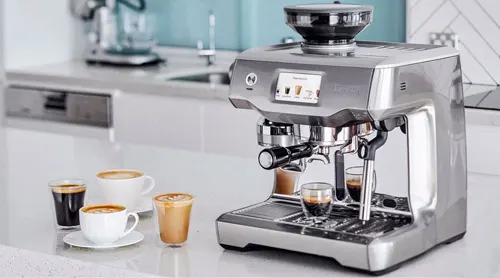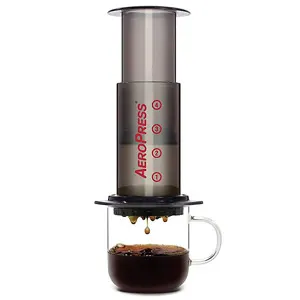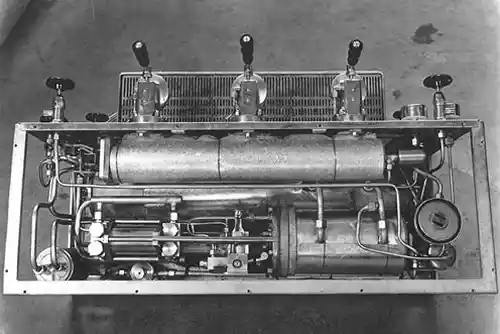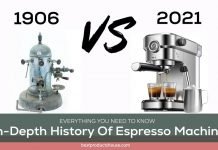Almost all the articles or information about types of espresso machines on the internet are kinda wrong; so is the title of this article. There aren’t 18 different “types” of espresso machines in reality.
There are different variations and versions of it, altogether, it makes up to 18 for our case. To categorize all the 18 different espresso machines as different types would be the wrong thing to do. There are different standards to categorize them.
Imagine saying that there are two types of legs, one is the right leg and the other is the left leg. That’s hilarious right? The same goes for espresso machines. It’s super easy to get confused regarding this.

Let’s help you out to understand different types of espresso machines, along with their variants, versions, and mechanisms that developed over the years from the very beginning.
By the end of this, you will have crystal clear idea about all types of espresso machines, and you’d be able to comprehend different categories with ease.
Contents
Types, Variations, And Mechanism Of Espresso Machines With Names
Espresso machines are versatile machines and there are quite a few prospects in their evolution. First and foremost, would be the type. Automation of espresso machines has taken different routes and we’ll see all of that in detail later.
Second, we see variations used in boiler technology. And third, would be the mechanism upgrade over time. There is a load more stuff to discuss, to keep it simple, only a few important features are talked about in length along with different espresso machine names.
5 Different Types Of Espresso Machines
Espresso machines have evolved over the last 100 years. In the beginning, everything was manual. Slowly this changed and now everything is much simpler. Incorporated with new technology, machines of modern days have sensors, built-in grinders, integrated water heating technology, pumps, valves, tampers, computers, etc.
To make things even simpler, there is also a stovetop version for the espresso machine – it is called the Moka pot.
1) Manual Espresso Machine (AKA the Lever Machine):

In a manual espresso machine, the pressure for brewing is generated using brute force, or simply put, pressure by hand. Baristas press down on the lever using their body weight.
Another way pressure is generated is by using a piston. We talk about the piston-driven mechanism in detail later in the article.
Besides generating the brewing pressure, the barista is also responsible for all other prospects. The grinding, weighing, dosing, tamping, down to the exact timing of when the shot needs to be pulled.
Handling manual espresso machines with ease needs experience. Experienced baristas can pull great shots with the manual espresso machines since they’ve trained themselves to have flexibility in their training.
2) Semi Automatic Espresso Machine

Machines that use a pump to create a force for pressing in water are known as semi-automatic espresso machines. A three-way valve is present which helps in expelling the excess brewing pressure.
A semi-automatic machine comes with a boiler, a portafilter, a power switch that is responsible for the pump to perform. All these features come together and automate brewing. The extraction process is what needs to be monitored fully.
This renders the machine best for commercial use where baristas have the opportunity to showcase their dexterity and easily make required adjustments.
3) Automatic Espresso Machine

Much like the semi-automatic, an automatic espresso machine has all the same features. An added edge that automatic machines got is the brew time programmability.
A flowmeter is added in the group head, this provides the flexibility of programming the amount of water getting through, also the pump automatically turns off.
These espresso machines are mostly used in homes and office spaces. It doesn’t require the users to be skilled at pulling great shots rather this assists in pulling a decent shot.
4) Super Automatic Espresso Machine

Unlike the semi-automatic and automatic espresso machines, a super-automatic espresso machine has a complete automatic function. Starting from grinding, tamping, milk frothing, all are done at the press of a button.
These machines use a reservoir water source for brewing, and they also come with a built-in bean hopper and grinder which is pretty amazing. While milk frothing is mostly manual but for some models even provide an automated milk frothing carafe.
This type of automation takes control of everything. It offers programmability of grind type, drinks type and even serving size. The downside is it provides very little control in terms of shot quality.
Super-automatic machines are targeted for light use. Although they’re feature-packed it doesn’t take up much space considering the space it’d have taken for a separate grinder.
These kinds of machines are mostly for people who don’t want to put in effort for brewing. Super-automatic machines cut down the brewing process to function under “one-touch”.
5) Moka Pot Coffee – Stove Top Espresso Maker

These are stovetop espresso makers. Both Moka pots and espresso machines work using the same principle – brew under pressure. Although it is no match for modern espresso machines but the use of steam and pressure allows Moka pots to be considered under the broad spectrum.
In terms of similarity to a conventional espresso maker, Moka pots are capable of delivering the same level of extraction. Though a lot comes down to grind size and bean type.
In contrast, the pressure level in Moka pots is much lower than in a conventional espresso machine. For example – an espresso maker can easily produce 9bars of pressure consistently. A Moka pot can only make around 1 to 1.5 bars of pressure.
Even when it comes to regulating temperatures, the disparity is huge. A Moka pot uses a combination of steam and boiling water above 100 °C. Espresso machines use a temperature of around 92-96 °C.
The Moka pot has three chambers. The bottom chamber holds water. In the middle chamber, we see a filter compartment that holds the ground coffee. This chamber has its filter end sitting in the bottom chamber and the funnel part of the chamber in the top compartment.
So, when the steam and boiling water compressed coffee and expelled it through the top it bubbled out in the top compartment. This is how you brew coffee using a Moka pot.
Let’s Watch a Video:
4 Mechanism Of Espresso Machine
Espresso machines have evolved over time and so has their mechanism. While the key mechanism behind every machine is the same the drive mechanism upgraded over time.
Achille Gaggia of Gaggia came up with the idea of a lever-driven or piston-driven mechanism. The idea was to make it convenient for the operator to brew a cup of espresso having full control over the process. This is why it’s also known as manual espresso machines.
1) Steam-Driven Espresso Machine

Earlier we’ve already seen Desidero Pavoni and Luigi Bezzera selling the idea of “steam equals speed” in 1884. You can also read the history of espresso.
Steam-driven coffee machines had a common boiler that was hooked to multiple group heads. This enabled the machine to deliver multiple cups of coffee at once. This design is low-cost and still used in Italy to this day.
Steam-driven machines fail to keep consistent pressure that results in crema from the ground coffee beans as a sign of poor-quality espresso.
2) Piston Driven Espresso Machine

In 1945 Gaggia introduced two types of lever function – manual and a spring-piston. The lever-driven machines had handles on them and on pulling on those handles the operator just needs to press down with their body weight for espresso extraction.
The spring mechanism requires building up tension on the spring, which transformed into the pressure buildup needed for extraction.
3) Pump Driven Espresso Machine

Pump-driven is the refined version of the piston-driven machine. This version has been around since 1961 and has been deemed to be the most popular commercial espresso machine design. Espresso machines get their water from either a water tank or directly from a water line
Since 1961 pump-driven espresso machine has been the commercial grade standard. To maintain high-pressure flow and concise temperature an electric-based system was introduced. A solenoid is an electromagnet wrapped around with springs. This helps maintain the flow of consistent temperature.
Pump-driven technology is seen in commercial espresso machines, they also have a water line directly linked to the system for convenience. Smaller home use espresso machines come with a separate water reservoir.
Homes and offices do not need to churn up a lot of coffee so the idea of having a water tank sits better than getting a water line linked like the commercial espresso machines.
4) Air-Pump-Driven / Handheld Machine

AeroPress is an air-pump-driven device that was invented and introduced in 2005, by an American named Alan Adler. In 2007 another similar device was invented by a French innovation house called Handpresso Wild.

The idea was to use compressed air to create a force. This force is meant to push hot water through the ground coffee beans. These air pumps are N2 or CO2-based electric compressors. These are much smaller and lighter than a conventional espresso machine.
4 Variations In Boilers Of Espresso Machines
There are different editions of the pump-driven espresso machines. These editions are based on the different boiler technology. There are four boiler technologies –
1) Single Boiler Espresso Machine

As the name suggests the machine has only one boiler that is dedicated to brewing. For steaming or frothing the milk with the steam wand the single boilers’ temperatures are not eligible.
Although some manufacturers include the steam wand feature, a single boiler is mainly designed for brewing, and quality steaming purposes can’t be expected.
2) Single Boiler Espresso Machine With Dual Use

This is an espresso machine with a single boiler, however, this one has the capacity to produce enough power to support a steam wand/milk frother along with regular brewing. That is what the name dual-use refers to.
A single boiler with dual-use has a thermostat that can assist in doubling up for both the options just not instantaneously. It requires an interval of time to make the transition from brewing to steaming.
Brewing does not require a high temperature but steaming does, so, the interval is necessary for the single boiler to heat a level higher. Hence, a thermostat-infused single-boiler espresso machine can be expected for quality steam wand performance.
Note: After brewing excess water is expelled from the machine using the steam wand. This ensures the frothed milk does not taste watered down.
These models are mostly seen in homes and offices where the crowd is limited.
3) Dual Boiler Espresso Machine

Dual boiler technology uses two separate boilers, one is dedicated for steaming while the other one is for heating. One boiler exclusively works on heating the water and the other i.e., thermo-block is used for elevating the temperature of the brewing water into steaming levels.
This technology is mostly seen in a higher range of espresso machines since they do so well in keeping a good balance between brewing and steaming.
4) Heat Exchanger Espresso Machine

Unlike the dual boiler technology, the heat exchanger has the capability of producing great espressos using a single boiler. The single boiler in action always keeps the temperature stable for steaming, so, when it comes to brewing the machine uses a cooling flush technology.
Using this cooling technology, the steaming hot water dives down in temperatures that take about 4 to 6 seconds. Although the water takes a drop in temperature but relatively it is still too hot for brewing.
Once this espresso machine uses the cooling flush technology it can pump up consecutive espresso shots without a hitch. If this sits idle for a significant time then the whole cooling flush technology needs to be revamped again.
Dual boiler technology baits steaming performances for brewing consistency whereas the heat exchanger technology compromises on brewing temperatures to make up for steaming excellence.
These espresso machines are not the best pick for commercial use maybe but they can do a pretty decent job at low-volume cafes and restaurants.
Few More Features Or Variations
Volumetric Espresso Machine

Espresso machines that monitor the water flow and automatically stop after the programmed volume are called volumetric espresso machines. The ratio of water to ground coffee has a significant role in the taste of espresso.
Using too much water or even less can throw off the balance in taste. So, it is crucial to have programmability of water flow.
Brewing is more fun and enjoyable when we can head straight to extracting espressos without having to guess Consistency in the espresso taste can be ensured with this technology.
Pod Coffee Maker For Espresso

These machines use the pod technology wherein a pod there is a certain amount of ground coffee, when it is time for extraction the machine uses a pump technology which creates an ample amount of pressure to brew a single shot of espresso.
We’ve come so far in terms of technology that now we can have different flavors and styles of coffee all pre-made. Pod-based espresso machines provide the highest level of convenience when it comes to the brewing experience.
Pour Over Espresso Machine

Most of the espresso machines are Pour over espresso machines which are also known as reservoir espresso machines. These espresso machines do not use a dedicated water line supply. Instead, these machines have a separate water tank. These tanks need refilling since they run out.
These kinds of espresso machines are mostly for people who do not heavily use their espresso machines and continuously keep on relocating their espresso machines.
Direct Connect Espresso Machine

Commercial espresso machines are the kind to have a dedicated water line. Unlike the reservoir espresso machines, the machines which have direct connections are used in commercial settings and have a dedicated space.
These machines regularly perform on high intensity. So, having to constantly check for the water in time of service is a major setback in commercial settings.
All cafes have a water supply line installed in their espresso machines for smooth operations. It requires professional assistance to install the water supply line for an espresso machine.
Integrated Grinder And Bean Hopper

Modern-day espresso machines have this excellent feature where the machine has its hopper and a burr grinder. This ensures fresh brewing as well as preserves the authentic flavor of the coffee bean.
Commercial spaces do not prefer these kinds of espresso machines. Since there are a lot of functions involved it doesn’t result in the best extraction.
For cafes, it is crucial to have a machine that focuses on one task and does it perfectly. Cafes use dedicated commercial espresso grinders and commercial espresso machines.
Professional spaces opt-out of these multi-functional espresso machines. They’re mostly aimed towards people who look for a compact design with high functionality.
Summing It Up
There’s no one way to categorize espresso machines, and each of the espresso machine types has their pros and cons. You can do it based on features, mechanism, size, or any other category that you prefer. Knowing the mechanisms and variations accordingly will allow you to understand any type or category of espresso machine without any problem. Whether you buy an espresso machine or help your friend to get one, no one can confuse you as they talk about different types of espresso machines.
Frequently Asked Questions (FAQs)
Espresso, Espresso romano, Doppio, Cappuccino, Latte, Espresso macchiato, Mocha.
It depends on your need and preferences. If you are a coffee aficionado or it’s a hassle to stand in line every day to get your favorite cup of coffee, then you should. It’s better to read our article on “types of espresso machine” to understand which one you should get.
Breville, Delonghi, Gaggia, Keurig, Nuova Simonelli, and Rancilio are some of the best espresso machine brands known currently.
Using an electric pump, water is passed into a boiler chamber. Then water is heated up, using a heating element, to make and build steam pressure. Then forced steam is passed through ground coffee beans to make espresso. Other than this, espresso machines have various types of features including timer, temperature sensor, and other complexes yet handy stuff.
The espresso handle is called a “portafilter”. It’s basically the removable basket where ground coffee is put and then attached to the espresso machine again so that steam can pass through it and give you a beautiful cup of fresh espresso.




![6 Best Drip Coffee Maker With Grinder [2023] Best Drip Coffee Maker With Grinder](https://www.bestproductshouse.com/wp-content/uploads/2022/05/Best-Drip-Coffee-Maker-With-Grinder-100x70.jpg)
I’m really enjoying the design and layout of your website. It’s a very easy on the eyes which makes it much more enjoyable for me to come here and visit more often. Did you hire out a developer to create your theme? Superb work!